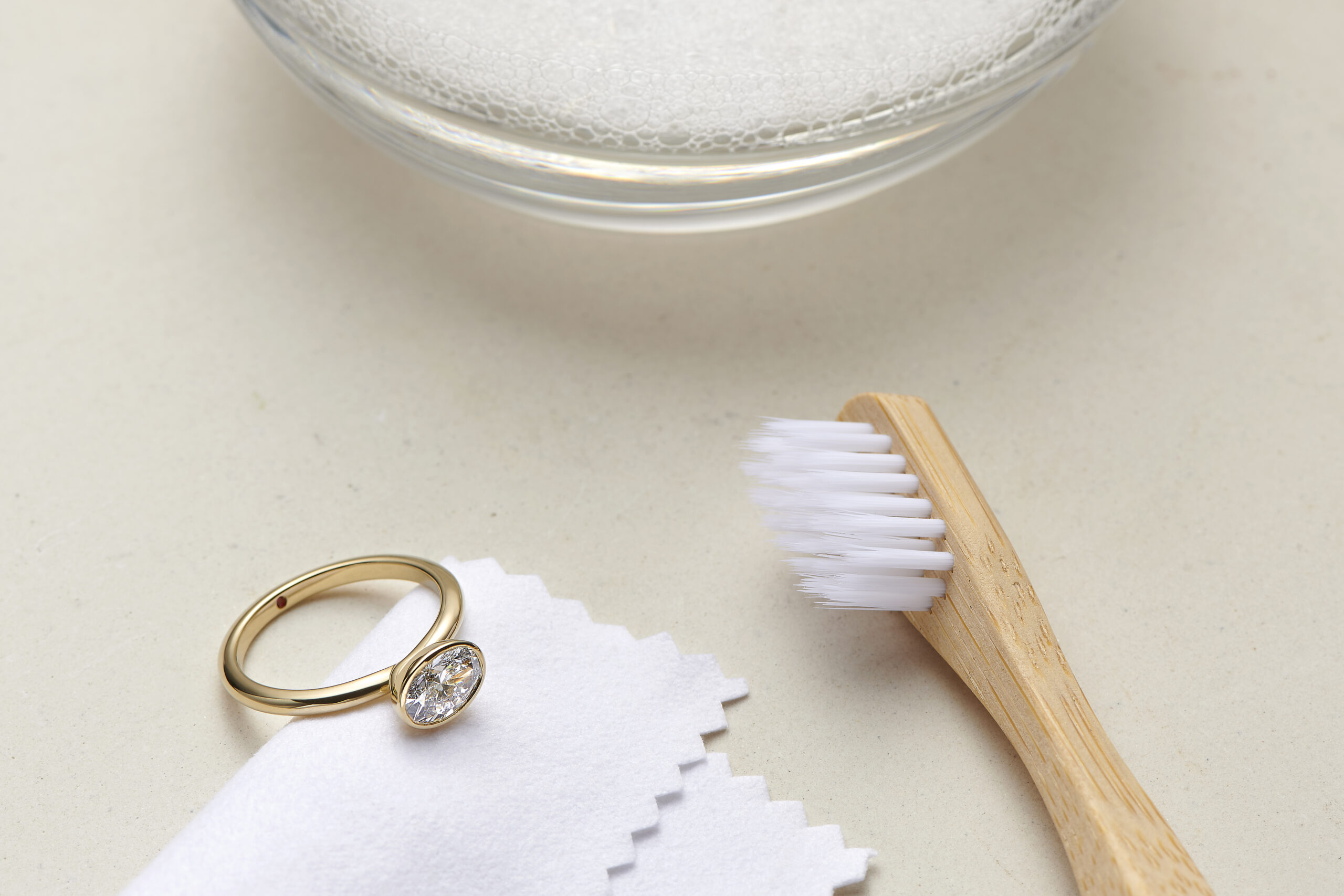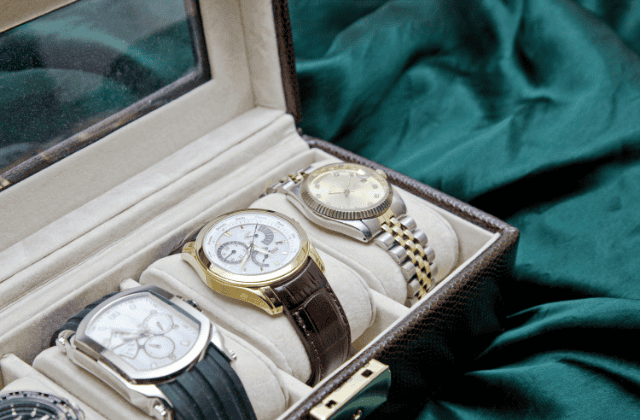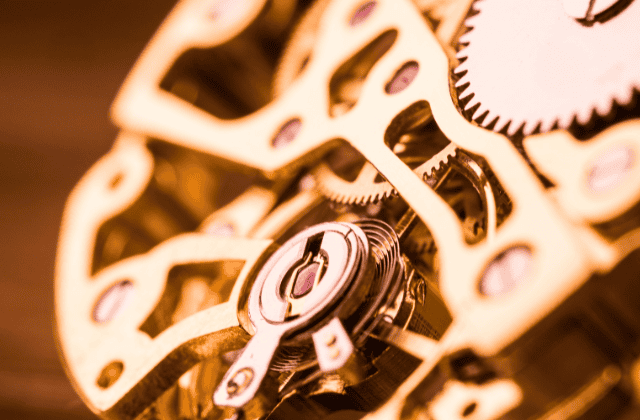Wondering when lab grown diamonds started?
You’re in the right place!
In this Learning Guide I’ll answer your most popular questions about the history of lab grown diamonds like:

- Who discovered lab grown diamonds?
- When was the first lab grown diamond made?
- When did lab grown diamonds start being sold?
What Are Lab Grown Diamonds?
Lab grown diamonds have come into their own since they first hit the diamond market. They are slowly shredding the stigma of being fake diamonds.
No, a lab diamond is a real diamond in every way except origin.
They have the same Mohs scale hardness rating as mined diamonds. There are different color nuances between natural diamonds and synthetic diamonds, but their entire composition is the same.
All laboratory grown diamonds have the same chemical, physical, and optical properties as earth made diamonds.
How Are Lab Diamonds Made?
The way lab diamonds are made today boils down to two main processes. Different companies have their own twists on how they make lab diamonds, but it’s usually these two methods: high pressure high temperature (HPHT) and chemical vapor deposition (CVD).
HPHT Diamonds
The HPHT method to create lab diamonds involves recreating the conditions under the earth that make natural diamonds crystallize.
They place a piece of a diamond called a diamond seed into pure carbon. It goes into a chamber and scientists apply high pressures and extreme heat to it. The heat and pressure forces the seed to crystallize into a diamond
CVD Diamonds
CVD diamonds use a diamond seed too. However, CVD diamonds only use a Type IIa diamond seed. Type IIa diamonds don’t have any nitrogen impurities and are found in 2% of the world’s diamonds.
Type IIa diamond seeds have been synthesized, which is why most CVD diamonds use HPHT diamond seeds.
It’s placed in a smaller vacuum chamber. Scientists fill the chamber with gases that are rich in carbon, like methane. The gases heat up and heat waves break them down.
The gas turns into a plasma once all of its molecules are broken down, leaving only carbon atoms behind. It coats the diamond seed and it turning into a growing diamond after it cools.
Read also: Differences Between HPHT and CVD
The History of Lab Grown Diamonds
To understand the history of lab grown diamonds, you must understand the history of natural diamonds too.
Diamonds have been present in the earth for billions of years. However, it was the discovery of diamonds in Africa which really starts our story.
When gemologists and researchers discovered that diamonds were made of pure carbon and happened under extreme temperatures and high heat, the race to synthesize was on.
Other gems had been synthesized at this point, so people wanted to do the same with diamonds.
Initially, people didn’t give diamonds as much attention as they do today. That’s because at the time, they didn’t know how to facet them and make them sparkle.
It wasn’t until Marcel Tolkowsky created the first natural ideal cut diamond in 1919. He optimized a piece of diamond rough to have perfect symmetry and proportions. The white and rainbow light reflected out of the diamond was beautiful, and drew the rich and royal in.
Once they discovered how to facet a diamond into a diamond shape besides round, all bets were off. They searched for a way to synthesize diamonds. There are so many requirements for diamond rough to become gem-quality, being able to synthesize them would save tens of thousands.
From that point on, all different companies began to conduct experiments to create diamonds. There were many different attempts as the race continued.
The Evolution of Synthetic Diamonds
- 1879 James Ballantyne attempts to create diamonds using barrels of carbon-rich minerals, but didn’t make diamonds
- 1887 Sir Charles Algernon Parsons started experimenting with rifle bullets to apply heat and pressure at a metal press with graphite in holes. He conducted a number of different experiments for years
- 1893 Ferdinand Frédéric Henri Moissan attempts to create lab diamonds and creates moissanite instead
- 1907 Otto Ruff said he created diamonds using Moissans work, then took it back
- 1926 Dr. J. Willard Hershey further expanded the research from Moissan and rough and created the first synthetic diamond in Kansas, USA. After further analysis, it wasn’t exactly diamond
- 1928 Hersey was believed to have created a synthetic diamond, but then told everyone that he believed nobody had successfully created a process to create diamonds. If they think they did, it was probably a lab-created spinel.
- 1949 Baltzar von Platen from ASEA Swedish Corporation attempts to create lab diamonds, but has trouble finding a press to simulate high pressure and high temperatures
- 1953 ASEA claims to have made a successful synthetic diamond, but kept it a secret until the 80s

Who Was the First to Make Lab Grown Diamonds?
Evidently, a lot of people attempted to make lab diamonds. Some were successful in some ways, and others not so much. But each person that conducted experiments paved the way for others.
The first gem-quality diamond produced using high temperature and high pressures with a diamond seed is credited to General Electric in 1954.
General Electric started their experiments around 1941. They had to put a hold on it because of World War II. The company resumed the experiments after the war ended in 1945.
Tracey Hall of General Electric created a belt press to create the conditions diamonds need to grow in 1954. Hall was a part of the team at General Electric, but his creation of the press was the key to synthesizing diamonds. However, they were tiny. The biggest diamond he created was .15 in diameter.
In 1955, Hall left his position at GE to work at Brigham Young University as a researcher and further expand his experiments
In 1960, Hall and his team got a patent for their synthesis of diamonds. The other two members were Herbert M. Strong and Robert H. Wentorf Jr. Hall also improved his press by creating a tetrahedral press.
Around 1971, GE created a gem quality 1 carat synthetic diamond.
In the 1980s, a Korean company Iljin Diamond successfully synthesized diamonds after obtaining trade secrets from an ex GE employee.
More and more companies began synthesizing diamonds after General Electric’s big announcement.
Failed Diamond Experiments Gone Right
There’s a lot of people and companies that have tried to synthesize diamonds. Majority of them have failed. But while they failed to create diamonds, they succeeded in creating other gemstones you’ll see in fine jewelry today.
1. Henry Moissan: Moissanite
Henry Moissan was digging in a crater in Arizona and came upon a sparkling colorless material that he thought was diamond. Turns out, it was natural moissanite. Natural moissanite is said to have come from space, earning it the name “Space Diamond”.
When Moissan tried to synthesize the stone he believed was diamond, he synthesized moissanite instead. Even though he didn’t make lab diamonds, this was a huge discovery.
Read also: Diamonds vs Moissanite – What’s the Difference?
Moissanite is the most popular diamond alternative for engagement rings in the jewelry industry today. It has high durability with 9.5 hardness and rainbow light performance like a disco ball.
If you’re interested in looking at moissanite, you should check out our friends over at Brilliant Earth. They allow you to create your moissanite ring from their loose moissanites and beautiful ring settings.
2. M. V. Stackelberg & K. Chudoba: Cubic Zirconia
Soviet scientists by the name of Stackelberg and Chudoba discovered the natural form of cubic zirconia in 1937. At the time, they assumed it was a diamond, but their experiments were halted by the war too.
When Was The First CVD Lab Diamond Created?
We talked about HPHT, the main method in which most lab diamonds are created. It emulates the same conditions natural diamonds go under using extreme pressure and extreme heat.
Remember our buddy Tracy Hall?
He was actually the first one to successfully create a CVD diamond, two years before GE announced HPHT diamonds. Technically, the first synthetic diamond was created by CVD method, even though it’s widely assumed HPHT diamonds came first.
The reason why is because the CVD diamonds he created weren’t gem quality like the HPHT diamond. Hall and his team were having a difficult time trying to create colorless diamonds. He was coming up with yellow and brown diamonds, not colorless CVD diamonds.

When Did Lab Grown Diamonds Start Being Sold?
I don’t have the exact date on when lab diamonds first started being sold. That being said, they were introduced commercially during the 1980s.
Lab diamonds didn’t become popular immediately. Many different natural diamond companies including De Beers were talking them down.
Lab grown diamonds gave the natural diamond industry a run for their money considering they can be 20 to 70% cheaper than a natural diamond of similar diamond grades.
Even though DeBeers also experimented with lab created diamonds in the early years, they have officially stepped into the lab diamond industry to offer them directly to consumers.
Marketing led to the inferiority of lab grown diamonds, even though they had the same light performance and wearability. They were advertised as ordinary, whereas a diamond was magical and rare.
Natural diamonds were romanticized and lab diamonds were advertised as factory made stones. They also had a whirlwind of confusing names like synthetic diamonds, cultured diamonds, cultivated diamonds, man made diamonds, etc.
The confusion led to misunderstandings about the lab diamond. Many thought synthetic diamonds meant fake diamonds. That’s not the case. Lab diamonds are real diamonds.
Read also: Natural or Man Made Diamonds – which to pick?
We really have the millennial generation and those who have come after for the demand in lab diamonds today.
And the movie Blood Diamond.
With the release of the movie Blood Diamond, many people started questioning mining practices and conflict diamonds.
Even though we only support companies that use the Kimberley Process, having a lab grown diamond is the only way to ensure your diamond is 100% conflict-free.

That doesn’t mean that every earth mined diamond is secretly a conflict diamond. Only 1-2% of the world’s diamonds are conflict-diamonds. They’re usually sold on the black market, not at a diamond retailer.
But still, many people are skeptical.
Not only were they concerned about diamond mining practices, but ethical and environmental practices. Lab grown diamonds aren’t sustainable, but they use a lot less energy than the mining process for natural diamonds.
If being ethical and energy isn’t enough for you, the price point is usually the deciding factor. Millennials and the younger generations are more concerned about improving their quality of life rather than spending more on a mined diamond.
However, the National Diamond Council, the Gemological Institute of America, and the FTC wanted to clear up miscommunications about lab diamonds.
They wanted people to know that lab diamonds don’t have great resale value and don’t offer trade-ins or upgrades on their stones. The exception to this is Ada Diamonds.
The FTC also warned all companies presenting lab diamonds as the sustainable option or eco friendly option, unless they could prove it.
In 2019, the lab diamond industry gained more popularity when Meghan Markle wore a pair of lab diamond earrings.
According to a survey done by The Knot, 1 in 4 engagement rings choose a lab created diamond or diamond simulants/alternatives for their center stone.
Where to Buy Lab Grown Diamonds
If you’re wondering where a good place to buy a lab grown diamond engagement ring is, look no further than our top 3 lab diamond sellers below:
1. James Allen
Why we love them: Wide selection, best lab diamond prices, free lifetime warranty covering ring settings.
2. Brilliant Earth
Why we love them: Large colored man made diamond collections, socially conscious brand, also provides traceable natural diamonds or natural diamonds with GIA Origin Reports, uses recycled metals and eco-friendly packing materials.
Conclusion
Even though lab grown diamonds are still fairly new to the industry, a lot has happened to them over their years and now there are more reasons why you should buy LGDs than ever.
The evolution of lab grown diamonds started in the 1800s and still continues today.
There were many people that contributed to General Electric’s development of the first official lab grown diamond.
So, what’s next for lab grown diamonds?
We can’t be sure, but it would a great thing if we could learn how to make all lab grown diamond sustainable and help the environment (and our wallets) even more.
That’s what I’d like to see in the future. How about you?







